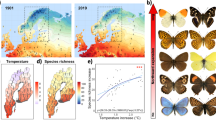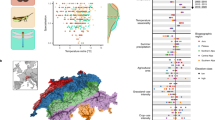Abstract
Habitat degradation and climate change are thought to be altering the distributions and abundances of animals and plants throughout the world, but their combined impacts have not been assessed for any species assemblage1,2,3,4. Here we evaluated changes in the distribution sizes and abundances of 46 species of butterflies that approach their northern climatic range margins in Britain—where changes in climate and habitat are opposing forces. These insects might be expected to have responded positively to climate warming over the past 30 years, yet three-quarters of them declined: negative responses to habitat loss have outweighed positive responses to climate warming. Half of the species that were mobile and habitat generalists increased their distribution sites over this period (consistent with a climate explanation), whereas the other generalists and 89% of the habitat specialists declined in distribution size (consistent with habitat limitation). Changes in population abundances closely matched changes in distributions. The dual forces of habitat modification and climate change are likely to cause specialists to decline, leaving biological communities with reduced numbers of species and dominated by mobile and widespread habitat generalists.
This is a preview of subscription content, access via your institution
Access options
Subscribe to this journal
Receive 51 print issues and online access
$199.00 per year
only $3.90 per issue
Buy this article
- Purchase on SpringerLink
- Instant access to full article PDF
Prices may be subject to local taxes which are calculated during checkout




Similar content being viewed by others
References
Thomas, J. A., Rose, R. J., Clarke, R. T., Thomas, C. D. & Webb, N. R. Intraspecific variation in habitat availability among ectothermic animals near their climatic limits and at their centres of range. Funct. Ecol. 13, 55–64 (1999).
Hill, J. K. et al. Impacts of landscape structure on butterfly range expansion. Ecol. Lett. 4, 313–321 (2001).
Coope, G. R. in Insects in a Changing Environment (eds Harringon, R. & Stork, N.) 29–48 (Academic, London, 1995).
Groombridge, B. Global Biodiversity (Chapman & Hall, London, 1992).
Jones, P. D. & Hulme, M. in Climates of the British Isles: Present, Past and Future (eds Hulme, M. & Barrow, E.) 173–196 (Routledge, London, 1997).
Roy, D. B. & Sparks, T. H. Phenology of British butterflies and climate change. Glob. Change Biol. 6, 407–416 (2000).
Thomas, J. A. Holocene climate changes and warm man-made refugia may explain why a sixth of British butterflies possess unnatural early-successional habitats. Ecography 16, 278–284 (1993).
Thomas, J. A., Moss, D. & Pollard, E. Increased fluctuations by butterfly populations towards the northern margins of species' ranges. Ecography 17, 215–220 (1994).
Roy, D. B., Rothery, P., Moss, D., Polalrd, E. & Thomas, J. A. Butterfly numbers and weather: predicting historical trends in abundance and the future effects of climate change. J. Anim. Ecol. 70, 201–217 (2001).
Parmesan, C. et al. Poleward shifts in geographical ranges of butterfly species associated with regional warming. Nature 399, 579–583 (1999).
Hughes, L. Biological consequences of global warming: is the signal already present? Trends Ecol. Evol. 15, 56–61 (2000).
Hill, J. K., Thomas, C. D. & Huntley, B. Climate and habitat availability determine 20th century changes in a butterfly's range margins. Proc. R. Soc. Lond. B 266, 1197–1206 (1999).
Asher, J. et al. The Millennium Atlas of Butterflies in Britain and Ireland (Oxford Univ. Press, Oxford, 2001).
Pollard, E. & Yates, T. J. Monitoring Butterflies for Ecology and Conservation (Chapman & Hall, London, 1993).
Dennis, R. L. H. & Shreeve, T. G. Diversity of butterflies on British Islands: ecological influences underlying the roles of area and isolation and the size of the faunal source. Biol. J. Linn. Soc. 60, 257–275 (1997).
Heath, J., Pollard, E. & Thomas, J. A. Atlas of Butterflies in Britain and Ireland (Viking, Harmondsworth, 1984).
Thomas, C. D. Dispersal and extinction in fragmented landscapes. Proc. R. Soc. Lond. B 267, 139–145 (2000).
Hill, J. K., Thomas, C. D., Fox, R., Moss, D. & Huntley, B. in Insect Movement: Mechanisms and Consequences (eds Woiwod, I., Reynolds, D. & Thomas, C. D.) 415–441 (CABI, London, 2001).
Thomas, C. D. et al. Ecological and evolutionary processes at expanding range margins. Nature 411, 577–581 (2001).
Cowley, M. J. R., Thomas, C. D., Thomas, J. A. & Warren, M. S. Flight areas of British butterflies: assessing species status and decline. Proc. R. Soc. Lond. B 266, 1587–1592 (1999).
Maes, D. & Van Dyck, H. Butterfly diversity loss in Flanders (north Belgium): Europe's worst case scenario? Biol. Conserv. 99, 263–276 (2001).
Huntley, B., Berry, P. M., Cramer, W. & McDonald, A. Modelling present and potential future ranges of some European higher plants using climate response surfaces. J. Biogeog. 22, 967–1001 (1995).
Tolman, T. Butterflies of Britain and Europe (HarperCollins, London, 1997).
Monserud, R. A. & Leemans, R. Comparing global vegetation maps with the Kappa statistic. Ecol. Model 62, 275–293 (1992).
Van Swaay, C. & Warren, M. S. Red Data Book of European Butterflies (Rhopalocera) (Nature and Environment Series No. 99, Council of Europe, Strasbourg, 1999).
Moss, D. & Pollard, E. Calculation of collated indices of abundance of butterflies based on monitored sites. Ecol. Entomol. 18, 77–83 (1993).
Cowley, M. J. R. et al. Density-distribution relationships in British butterflies. I. The effect of mobility and spatial scale. J. Anim. Ecol. 70, 410–425 (2001).
Purvis, A. & Rambaut, A. Comparative analysis by independent contrasts (CAIC): an Apple Macintosh application for analysing comparative data. Comp. Appl. Biosci. 11, 247–251 (1995).
Leemans, R. & Cramer, W. Research Report RR-91-18 (International Institute for Applied Systems Analysis (IIASA), Laxenburg, Austria, 1991).
Acknowledgements
We thank the many thousand recorders who contributed to the atlas surveys and transect schemes. We also thank W. Cramer for providing the spline surfaces used to interpolate the climate anomalies, and P. Mayhew for giving helpful advice on using CAIC. This work was supported by the Butterfly Conservation, the Esmée Fairbairn Foundation, the Vincent Wildlife Trust, the Joint Nature Conservation Committee, the Centre for Ecology and Hydrology, and NERC.
Author information
Authors and Affiliations
Corresponding author
Rights and permissions
About this article
Cite this article
Warren, M., Hill, J., Thomas, J. et al. Rapid responses of British butterflies to opposing forces of climate and habitat change. Nature 414, 65–69 (2001). https://doi.org/10.1038/35102054
Received:
Accepted:
Issue Date:
DOI: https://doi.org/10.1038/35102054



